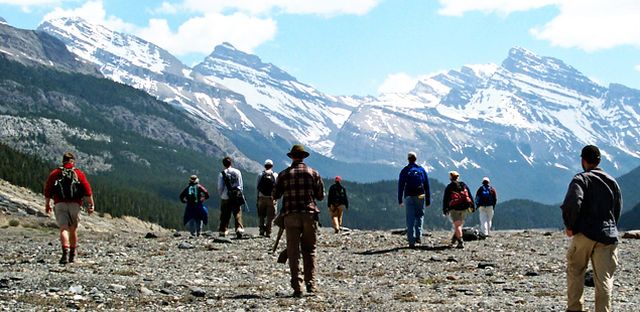
Geology Faculty Publications
Document Type
Article
Publication Date
2011
Publication Source
GSA Field Guides
Abstract
This field trip examines contrasting lines of evidence bearing on the timing and structural style of Cenozoic (and perhaps late Mesozoic) extensional deformation in northeastern Nevada. Studies of metamorphic core complexes in this region report extension beginning in the early Cenozoic or even Late Cretaceous, peaking in the Eocene and Oligocene, and being largely over before the onset of “modern” Basin and Range extension in the middle Miocene. In contrast, studies based on low- temperature thermochronology and geologic mapping of Eocene and Miocene volcanic and sedimentary deposits report only minor, localized extension in the Eocene, no extension at all in the Oligocene and early Miocene, and major, regional extension in the middle Miocene.
A wealth of thermochronologic and thermobarometric data indicate that the Ruby Mountains–East Humboldt Range metamorphic core complex (RMEH) underwent ~170 °C of cooling and 4 kbar of decompression between ca. 85 and ca. 50 Ma, and another 450 °C cooling and 4–5 kbar decompression between ca. 50 and ca. 21 Ma. These data require ~30 km of exhumation in at least two episodes, accommodated at least in part by Eocene to early Miocene displacement on the major west-dipping mylonitic zone and detachment fault bounding the RMEH on the west (the mylonitic zone may also have been active during an earlier phase of crustal extension). Meanwhile, Eocene paleovalleys containing 45–40 Ma ash-flow tuffs drained eastward from northern Nevada to the Uinta Basin in Utah, and continuity of these paleovalleys and infilling tuffs across the region indicate little, if any deformation by faults during their deposition. Pre–45 Ma deformation is less constrained, but the absence of Cenozoic sedimentary deposits and mappable normal faults older than 45 Ma is also consistent with only minor (if any) brittle deformation. The presence of ≤1 km of late Eocene sedimentary—especially lacustrine—deposits and a low-angle angular unconformity between ca. 40 and 38 Ma rocks attest to an episode of normal faulting at ca. 40 Ma.
Arguably the greatest conundrum is how much extension occurred between ca. 35 and 17 Ma. Major exhumation of the RMEH is interpreted to have taken place in the late Oligocene and early Miocene, but rocks of any kind deposited during this interval are scarce in northeastern Nevada and absent in the vicinity of the RMEH itself. In most places, no angular unconformity is present between late Eocene and middle Miocene rocks, indicating little or no tilting between the late Eocene and middle Miocene. Opinions among authors of this report differ, however, as to whether this indicates no extension during the same time interval. The one locality where Oligocene deposits have been documented is Copper Basin, where Oligocene (32.5– 29.5 Ma) conglomerates are ~500 m thick. The contact between Oligocene and Eocene rocks in Copper Basin is conformable, and the rocks are uniformly tilted ~25° NW, opposite to a normal fault system dipping ~35° SE. Middle Miocene rhyolite (ca. 16 Ma) rests nonconformably on the metamorphosed lower plate of this fault system and appears to rest on the tilted upper-plate rocks with angular unconformity, but the contact is not physically exposed. Different authors of this report interpret geologic relations in Copper Basin to indicate either (1) signifi cant episodes of extension in the Eocene, Oligocene, and middle Miocene or (2) minor extension in the Eocene, uncertainty about the Oligocene, and major extension in the middle Miocene.
An episode of major middle Miocene extension beginning at ca. 16–17 Ma is indicated by thick (up to 5 km) accumulations of sedimentary deposits in half-graben basins over most of northern Nevada, tilting and fanning of dips in the synextensional sedimentary deposits, and apatite fi ssion-track and (U-Th)/He data from the southern Ruby Mountains and other ranges that indicate rapid middle Miocene cooling through near-surface temperatures (~120–40 °C). Opinions among authors of this report differ as to whether this period of extension was merely the last step in a long history of extensional faulting dating back at least to the Eocene, or whether it accounts for most of the Cenozoic deformation in northeastern Nevada. Since 10– 12 Ma, extension appears to have slowed greatly and been accommodated by highangle, relatively wide-spaced normal faults that give topographic form to the modern ranges. Despite the low present-day rate of extension, normal faults are active and have generated damaging earthquakes as recently as 2008.
Inclusive pages
27–66
ISBN/ISSN
2333-0937
Document Version
Published Version
Copyright
Copyright © 2011, Geological Society of America
Publisher
Geological Society of America
Volume
21
Peer Reviewed
yes
eCommons Citation
Henry, Christopher D.; McGrew, Allen J.; Colgan, Joseph P.; Snoke, Arthur W.; and Brueseke, Matthew E., "Timing, Distribution, Amount, and Style of Cenozoic Extension in the Northern Great Basin" (2011). Geology Faculty Publications. 33.
https://ecommons.udayton.edu/geo_fac_pub/33
Included in
Geology Commons, Geomorphology Commons, Geophysics and Seismology Commons, Glaciology Commons, Hydrology Commons, Other Environmental Sciences Commons, Paleontology Commons, Sedimentology Commons, Soil Science Commons, Stratigraphy Commons, Tectonics and Structure Commons



Comments
This document is provided for download by permission of the publisher. The article is also available on the publisher's website.
Permission documentation is on file.